Mastering Skateboarding with Your Dog: A Training Guide
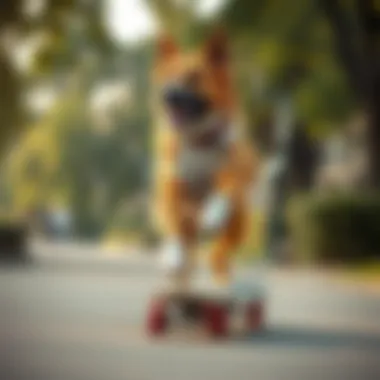
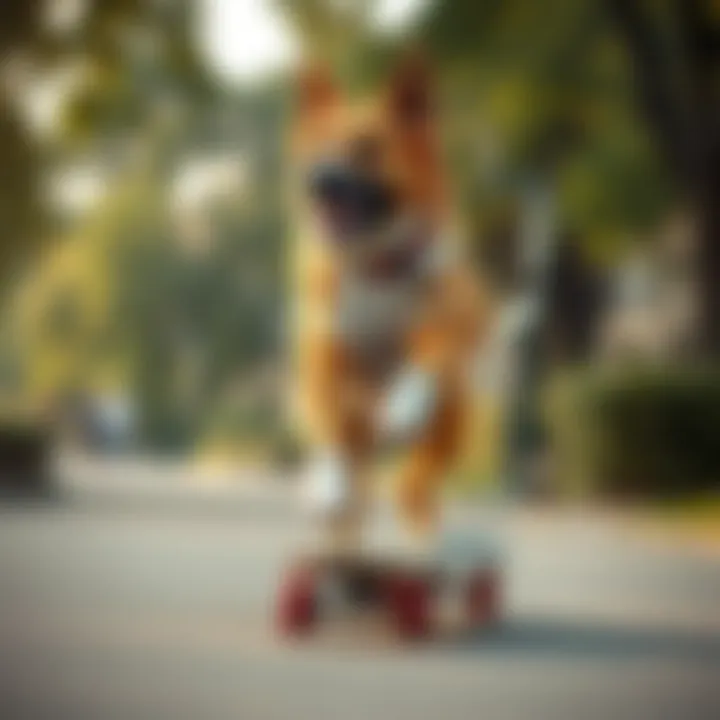
Intro
Teaching a dog to skateboard might seem outlandish at first glance, but it’s an exciting and rewarding endeavor that blends playfulness with skill training. This guide doesn’t just skim the surface; we’ll delve into the nuances of training, ensuring your four-legged friend rolls through the park with style.
While it’s easy to think this process involves simply jumping on a board and cruising, there are numerous facets to consider. From establishing trust with your dog, to ensuring their physical readiness, each step can make the difference between a successful skateboarding session and a muddled mess. Simply put, it’s about more than just skateboarding; it’s about building a relationship.
In this article, we will cover several key areas that contribute to successful skateboarding with your canine companion:
- The importance of regular pet care and grooming for a skateboard-ready dog
- Key health and nutritional considerations that support physical activity
- Effective positive reinforcement training techniques suited specifically for teaching new tricks like skating
- Engaging activities that go hand in hand with skateboarding, enhancing enjoyment and bond
- Resources available to pet owners looking to connect with the broader community for support and guidance
By navigating through these elements, you’ll not only teach your dog how to skate but also foster a deeper connection that will last a lifetime.
Understanding the Basics of Dog Training
Teaching a dog to skateboard isn't just about throwing them onto a board and expecting them to glide around like a pro. It requires a foundational understanding of dog training principles. This can make the difference between a four-legged daredevil and a scared pup clinging to your leg. Getting the basics down lays the groundwork for a successful skateboarding journey, ensuring a satisfying and enjoyable experience for both owner and dog.
The Importance of Positive Reinforcement
Positive reinforcement is your best friend in dog training. It’s like offering a cherry on top of a sundae—the more enticing you make the reward, the more likely your dog is to repeat the desired behavior. This technique involves rewarding your dog when it performs a command or behavior correctly. Whether it’s through treats, praise, or play time, these positive outcomes motivate your pup to engage with the skateboard.
For instance, if your dog takes a step onto the skateboard and you immediately reward them, they'll gradually start associating that board with good things. This builds their confidence and keeps them eager to learn. Remember, every small win counts and can lead to some pretty impressive tricks down the line.
Establishing a Communication Framework
Dogs aren’t mind readers, nor are they fluent in English. A clear communication system between you and your dog is essential for successful training. This framework can include verbal commands, hand signals, or even consistent sounds like clicks.
Using a consistent command like "board" or "skate" can make a world of difference. Your dog learns to associate that specific word with the desired action. Pairing this with a signal helps clarify what you want them to do. The more predictable your cues, the clearer the message; and clarity fosters trust. As your dog starts to grasp this framework, you might notice they begin to respond to the board with enthusiasm rather than trepidation, paving the way for more advanced training.
Setting Realistic Expectations
When embarking on a venture like teaching your dog to skateboard, setting realistic expectations can save you from a heap of frustration. Just like learning any new skill, it’s crucial to understand that progress might be slow and uneven. Not every dog will take to a skateboard like a duck to water.
Some breeds, due to their physical build or temperament, may find the whole experience overwhelming. That's okay. Adapt your training timeline based on your dog's individual needs. For example, conduct shorter training sessions, focusing on small manageable tasks rather than expecting your pooch to nail a complex trick on day one. Patience and persistence are your sturdiest allies.
The key to success in dog training isn’t just about results; it’s about enjoying the journey together.
Understanding these foundational concepts allows you to create a comfortable and supportive learning environment for your dog. As you dive deeper into the techniques of skateboarding together, these basic principles will serve as your guiding light.
Selecting the Right Dog for Skateboarding
Choosing the right dog for skateboarding is more than just a matter of picking a breed. It involves understanding both the physical attributes and temperament of your dog. Not all dogs are meant to be skateboarders, and factors such as size, agility, and personality come into play. Picking a dog with the right characteristics sets the stage for a successful and enjoyable training experience.
Physical Attributes Suitable for Skateboarding
When considering a dog’s physical traits, look for several key characteristics. Firstly, the dog should have a good balance of size and weight. Smaller dogs like French Bulldogs or Toy Poodles may struggle with stability, while larger breeds like Huskies or Goldens may be too heavy to easily control. Therefore, medium-sized dogs typically hit the sweet spot; breeds such as Beagles or Cocker Spaniels often fit the bill nicely.
Agility is another crucial trait. Dogs with a naturally agile body, such as Border Collies, tend to perform well. A dog that can pivot quickly and has a strong musculature will find it easier to maintain balance and coordination on a skateboard.
The paw structure also matters. Dogs with wider, sturdier paws tend to provide better grip and stability. This can help prevent slips and falls while doing tricks or even just rolling on the board.
Consider the age of the dog as well. Young dogs, typically full of energy and curiosity, may take to skateboarding more readily than older dogs who might have mobility issues or decreased energy. However, it is important to ensure they are fully grown, as puppies have not yet developed the physical strength and stability necessary for handling a skateboard.
Remember: A dog’s age and physicality can either be a roadblock or a launchpad for skateboarding adventures!
Temperament Considerations
Beyond physical attributes, selecting a dog with the right temperament is equally essential. A curious and adventurous spirit can go a long way when introducing a dog to skateboarding. Dogs that are overly skittish or anxious may have a hard time adapting to the movement of a skateboard, resulting in fear rather than fun.
Look for dogs that display playful characteristics. Those who enjoy chasing and are willing to try new things tend to handle the learning process better. For example, a playful Golden Retriever may excitedly hop on a stationary skateboard just for the fun of it, while a more reserved breed may be less inclined.
Intelligence also plays a crucial role in successful skateboarding training. Smart breeds such as Poodles or German Shepherds can not only learn commands quickly but also adapt to the nuances of balancing on a skateboard. An intelligent dog will understand cues from its owner and pick up on tricks quicker than those that may not be as sharp.
Lastly, consider the dog's sociability. A dog that interacts well with people and other dogs can become a better skateboarder. That social aspect helps enhance confidence, and a confident dog is more likely to take the leap onto the moving board without hesitation.
In summary, selecting the right dog for skateboarding is an intricate process that hinges on understanding both physical attributes and temperament. Pay attention to characteristics such as size, agility, and personality to maximize fun, safety, and success in your skateboarding journey.
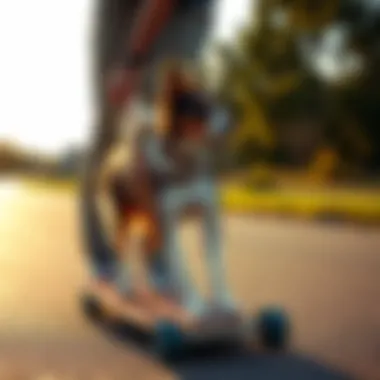

Preparing Your Dog for Skateboarding
Preparing your dog for skateboarding isn’t just about getting them to hop on a board and cruise around. It’s a foundational stage that sets the tone for all that follows. The essence of this preparation is to ensure that your dog is not only physically capable but also mentally ready to embrace the experience of riding a skateboard. Teaching a dog to skateboard combines physical fitness, familiarity with the equipment, and basic obedience commands. Without this groundwork, the whole endeavor can become a frustrating ordeal for both owner and pet.
As you embark on this journey, consider the significance of holistic preparation. This stage ensures the safety and enjoyment of the activity, which in turn fosters a deeper bond between you and your canine companion.
Assessing Your Dog's Physical Fitness
Before your furry friend hops on a skateboard, it’s crucial to evaluate their physical fitness. Just like us humans, dogs need to be in good shape for new activities. A quick assessment can involve checking their general health, weight, and energy levels. Engage with your vet to confirm that your dog does not have any underlying health issues that could hinder their ability to skateboard safely.
- Weight Management: If your dog is carrying extra pounds, it might be best to introduce them to some tailored exercise routines before tackling the skateboard.
- Joint Health: If your dog is older or has any joint problems, they may not be suited for skateboarding. Keep an eye on how they move and play.
A well-conditioned dog will not only manage the physical demands of skateboarding better but will also face less risk of injury, making it an important consideration before you kick off your training sessions.
Familiarizing Your Dog with the Skateboard
You wouldn't put a toddler on a bike without a bit of preparation, right? The same goes for your dog and the skateboard. Introducing the skateboard gradually helps to demystify it and reduce any anxiety your dog may have. Start by letting them sniff the board, exploring it while it’s stationary. Positive experiences at this stage can significantly reduce any fear or anxiety.
- Introduce the Board in Familiar Surroundings: Place the skateboard in a space where your dog feels comfortable, like your living room or backyard.
- Let Them Explore: Encourage them to explore it without pressure. Use treats and praise to create a positive association.
Once your dog shows curiosity, you might gently roll the skateboard back and forth on the ground. The sound or movement shouldn't startle them; rather, it should pique their curiosity. Over time, they’ll learn that this piece of equipment is not a threat but a tool for fun.
Basic Commands to Teach
A sound understanding of basic commands is essential for effective skateboard training. Simple commands can provide a structure that helps your dog feel secure and aware during training sessions. Commands like "sit," "stay," and "come" are the building blocks of communication and will greatly aid in keeping your sessions productive and safe.
- "Sit": This command teaches your dog patience and control, making it easier to manage their excitement when introducing the board.
- "Stay": Helps in keeping them in the same spot when needed, especially when working on balancing on the board.
- "Come": A useful command that enables you to call your dog back to you quickly, a necessity if they become too adventurous on the skateboard.
Incorporating these commands into regular play or training sessions will build confidence and responsiveness, laying the groundwork for skateboarding success.
A well-prepared dog, both physically and mentally, enhances the overall skateboarding experience. This preparation phase is vital for ensuring safety and boosting your pup’s confidence as they learn to ride.
Introducing the Skateboard
Getting your dog ready to skateboard is a crucial step in the training process. Before you can expect them to glide with grace, it's vital to introduce the skateboard in a way that feels safe and familiar to them. This introduction serves to demystify the skateboard, ensuring that your furry friend sees it as a fun item rather than a potential threat. Understanding how to properly introduce the skateboard can make all the difference in how quickly and effectively your dog adopts this unique skill.
Choosing an Appropriate Skateboard
When it comes to selecting the right skateboard, there are several factors to take into account. Dog owners should look for a skateboard that is sturdy yet lightweight. A board that can withstand your dog's weight while still being easy to maneuver is ideal. Generally, something made from quality materials, like maple wood, will do the trick. Here are a few considerations:
- Size: The skateboard should be proportionate to your dog's size. Too big, and they might struggle; too small, and it won’t be stable enough.
- Wheels: Soft wheels provide a smoother ride, minimizing the impact noticed by your dog.
- Design: A non-slip surface can help your dog feel secure and stable.
Once you've chosen the skateboard, let your dog sniff it out. This simple act can eliminate curiosity-driven anxiety and can help build a sense of familiarity.
Creating a Safe Environment for Practice
Safety cannot be overstated when teaching your dog how to skateboard. You want to ensure a friendly atmosphere devoid of distracting elements that could cause stress. Select a flat and spacious area with minimal traffic. Here are several key points to consider:
- No Obstacles: Clear away anything that might trip your dog, like toys or fallen branches.
- Soft Surface: Grass or a smooth paved area minimizes the risk of injury from falls.
- Controlled Access: Keep your dog away from public spaces or crowded areas where they can become overwhelmed.
A designated training area promotes confidence and comfort, allowing your pooch to focus entirely on learning this fun new skill.
Begin with Motionless Skateboard Training
Starting your dog’s training with a stationary skateboard is essential. This step allows your dog to feel the skateboard beneath their paws without the distraction of movement. Here’s how to get this part right:
- Place the board on the ground in your safe training area.
- Allow your dog to explore the skateboard at their own pace. Offer treats for any interest shown, which can encourage a positive connection.
- Encourage them to step onto the skateboard by using treats or their favorite toy. Reward any attempt to get on it.
The goal is to make every experience associated with the skateboard positive. Gradually, as your dog becomes more comfortable, you can introduce the concept of movement. Starting slowly ensures a solid foundation, which is essential for more advanced tricks down the line.
Teaching Your Dog to Skateboard
Teaching your dog to skateboard is more than just a quirky trick; it reflects the trust and bond you foster with your furry friend. The process requires patience and understanding, as you're not only focusing on the mechanical act of riding a skateboard but also on enhancing your dog's agility, coordination, and confidence. As amusing as it might sound, skateboarding can offer significant benefits to both you and your pet. This journey encourages active participation from both sides, reinforcing positive behaviors while creating enjoyable shared experiences.
Incremental Motion Training
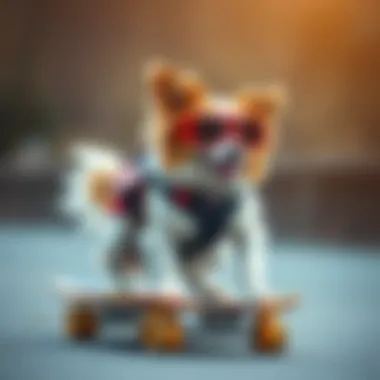
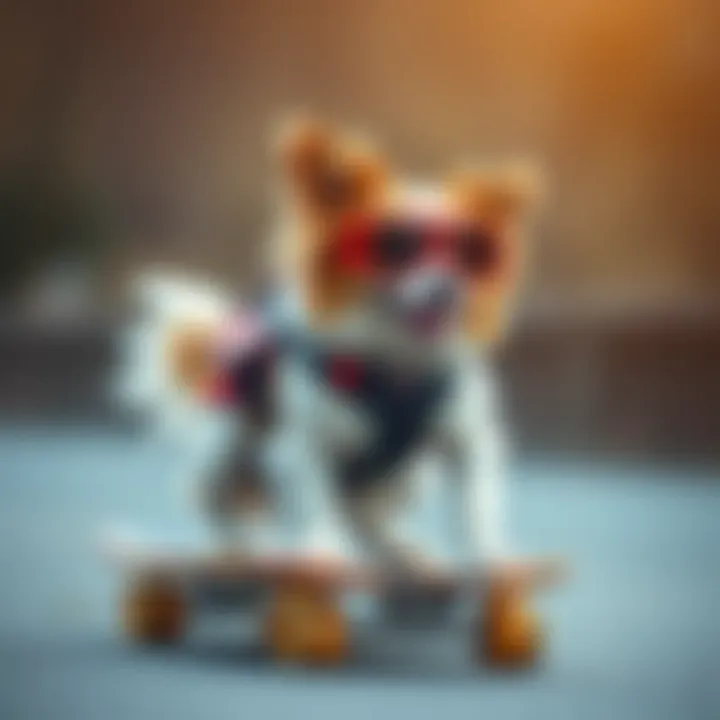
When it comes to introducing your dog to skateboarding, incremental motion training is key. This method involves gradually increasing the level of difficulty as your dog becomes more comfortable. Start with the skateboard stationary, allowing your dog to sniff and investigate the board. Next, you would have your pet learn to place its paws on it. Use treats to guide them gently, perhaps even inviting them to hop on while stationary, rewarding them profusely. As your dog grows accustomed to the board's texture and balance, you can begin to introduce slow movements. Think about using a gentle push or rolling the skateboard just a few inches. With each successful attempt, the dog gains confidence, and you can increase the speed. Remember, patience is a virtue, and moving at your dog’s pace is paramount.
Rewarding Progress Effectively
Rewarding your dog's progress effectively is crucial for motivation and reinforcement. Positive reinforcement can take many forms—treats, praise, or affection. When your dog achieves even the smallest milestone, whether it is stepping onto the board or balancing while it's rolling, shower them with encouragement. "Good job!" and "You did it!" work wonders. Over time, this establishes a connection between the behavior and the reward, encouraging them to keep trying. It’s important to be consistent in your rewards. If they learn that balancing equals a treat, they’re more likely to repeat that action. However, be careful not to over-reward; too many treats can backfire, leading to an unwanted weight issue.
Short Training Sessions and Consistency
Consistency is the name of the game in teaching your dog to skateboard. Keeping the training sessions short—about 10 to 15 minutes—helps to retain your dog's attention without overwhelming them. Dogs have short attention spans, so it’s wise to end each session on a positive note. Repeating training regularly, maybe three to four times a week, keeps the activity fresh in your dog's mind. Consistency in cues and commands also helps in solidifying their learning process.
Establish a routine. Maybe it’s the first thing in the morning or after a leisurely walk—whatever fits your schedule. Just make sure it’s that time together that you both look forward to. Consider maintaining a training journal to track progress, noting which techniques were successful and what areas might need a little more focus. This detail can be immensely helpful in creating a tailored approach that suits your dog’s unique learning style.
Safety Precautions for Training
When you're embarking on the journey of teaching your dog to skateboard, it's crucial not to overlook the safety measures involved in the process. This isn't just about keeping your pup from tumbling off the board; it's about ensuring a positive experience that fosters trust and enjoyment rather than fear or injury. Focusing on safety allows for a smoother learning curve and reinforces the bond you have with your dog, as they feel supported and secure.
Using Protective Gear for Your Dog
To keep your furry friend safe while skating, consider outfitting them with protective gear. Just like humans wear helmets and pads while skating, dogs can benefit from the same level of protection. Doggie helmets are becoming increasingly popular and are designed to fit snugly on your pet’s head. This can help prevent injuries in case of falls.
Additionally, investing in padded dog shoes can protect their paws from rough terrain and potential abrasions. Don’t forget about joint protectors for breeds that are prone to hip or elbow dysplasia. While some may think it looks silly, gear is better than nursing an injury later.
- Dog helmets
- Padded dog shoes
- Joint protectors
By getting your dog accustomed to wearing this gear gradually, you promote comfort and security, which is essential when they’re first learning to balance on a skateboard.
Recognizing Signs of Fatigue and Stress
During training, it’s essential to be observant. Your dog may not always voice their discomfort. Signs of fatigue can be subtle but are vital to recognize. Look for changes in their pace, like slowing down or excessive panting. If your dog starts to lose interest, it might be a sign they need a break.
Common indicators of stress to monitor include:
- Tucking tail or ears back
- Heavy breathing or exaggerated panting
- Avoiding the skateboard
It's wise to factor in short training sessions to avoid overwhelming your dog. Remember, repetition can be tiring, so when in doubt, give them a rest and offer some praise.
Practicing in Controlled Environments
Before hitting the open trail, start in a controlled environment. A quiet, familiar area allows your dog to get acquainted with the skateboard without the distractions of bustling parks or noisy streets. Control, both in your surroundings and the dog’s exposure, is paramount.
- Choose flat surfaces to minimize any hazards.
- Eliminate distractions, like other pets or children running around.
- Use a fenced area if available, keeping your focus solely on your furry friend.
This safer setting helps build your dog’s confidence, and they can learn at their own pace without fear of sudden distractions. Consistency and patience lead the way to success.
"Safety isn't just simple; it's essential. Take good care of your pup, and they'll take care of you with their joy and spirit."
Troubleshooting Common Issues
Teaching a dog how to skateboard can be a fun and rewarding experience. However, it's not without its challenges. When you hit those bumps in the road, knowing how to troubleshoot common issues can save you and your furry friend a lot of headaches. Addressing problems as they arise is crucial for maintaining both your dog's interest and its safety. This section will delve into common issues that may arise during the training process and effective strategies for overcoming them, ensuring a smooth learning experience for both of you.
Overcoming Fear of the Skateboard
Fear is a natural response for dogs when confronted with something new, especially a skateboard that rolls and makes noises. Recognizing this fear early on can prevent bigger issues later in the training. It’s essential to approach this situation with patience and understanding. Here are some effective strategies to ease your dog’s trepidation:
- Familiarization: Start by letting your dog sniff and explore the skateboard while it’s stationary. This helps to reduce the unknown aspect of it.
- Use of Treats: Encourage your dog to approach the skateboard with treats. All dogs have a price! If they associate the board with rewards, they're likely to become more comfortable.
- Gradual Introduction: Once your dog seems at ease with the stationary board, roll it slowly while your dog is nearby. This helps them acclimatize to the motion without being directly involved.
- Positive Reinforcement: Always follow moments of bravery with a treat or craftily delivered praise. Reinforcing positive behavior plays a big role in overcoming fear.
"The best way to deal with a phobia in dogs is a progressive exposure and lots of love."
Dealing with Distractions
Dogs are easily distracted, especially when there are sights, sounds, or smells around that intrigue them. Whether it’s a squirrel scurrying by or another dog barking down the street, distractions can derail training sessions. Here’s how to keep your focus on skateboarding:
- Find a Controlled Environment: Begin training in a quiet area where distractions are minimal. Parks might be tempting, but they could soon morph into chaotic scenes, making it hard for your pup to concentrate.
- Focus Commands: Teach your dog basic focus commands. Commands like "look at me" can redirect their attention back to you when distractions arise.
- Short Training Sessions: Keep sessions brief yet stimulating. If your dog starts to lose focus, it’s better to end the session on a good note rather than pushing through and making it a chore.
- Gradual Exposure: Slowly introduce distractions over time. Start in a quiet setting, then work your way towards busier environments to help your dog adjust.
Adjusting Techniques Based on Dog Behavior


Every dog is unique, and their responses to training vary greatly. What works for one might not work for another. Tune into your dog’s body language and mood during training sessions. Here’s how to adapt:
- Observation is Key: Pay attention to cues that indicate frustration or disinterest. A wagging tail or an eager stance often indicates excitement, while a tucked tail or turning away suggests discomfort.
- Modify Your Approach: If your dog seems overwhelmed by a particular exercise, break it down further or try a different technique. Maybe your dog prefers to learn in smaller steps rather than jumping in.
- Adjust Rewards: Some dogs are highly motivated by treats, while others respond better to praise or playtime. Experiment to see what motivates your dog most.
- Stay Flexible: Be prepared to switch gears during a session. If something’s not working, don’t be afraid to pivot. Sometimes, dogs just need a little break or a fresh activity.
These troubleshooting methods not only make the learning process smoother but also strengthen the bond between you and your dog. Successful training relies on adaptability, observation, and a touch of creativity. By being proactive about issues, you set the stage for a confident skateboarder in the making.
Maintaining Your Dog’s Interest in Skateboarding
Keeping your dog engaged in skateboarding goes beyond just teaching them the basics. It's an ongoing effort that allows both you and your dog to enjoy the process while ensuring that skateboarding doesn’t feel like a chore. Dogs, much like people, can get bored if the routine becomes stagnant. Therefore, a few strategic tactics can make all the difference in maintaining not only their interest but also their enthusiasm.
Incorporating Variations in Training
One of the best ways to keep your dog excited about skateboarding is to change things up. Here are some effective methods:
- Introduce New Tricks: Incorporating fun tricks that can be done on or off the skateboard can spark enthusiasm. For instance, teaching your dog to jump on and off the board can give them a challenge to look forward to.
- Alter Locations: Sometimes, a simple change of scenery can renew interest. Practicing skateboarding in different parks or open spaces might stimulate your dog’s curiosity and excitement.
- Vary the Equipment: Try using different types of boards, such as a longboard or a cruiser, for different experiences. The feel may be different for your dog, which could intrigue them.
"Variety is the spice of life, especially when it comes to keeping your dog engaged in their new favorite sport!"
Such variations not only help in maintaining interest but also encourage your dog to adapt and learn more—keeping their minds as agile as their bodies.
Socializing with Other Skateboarding Dogs
Another effective method to maintain your dog's interest is through socialization. Dogs are social animals and thrive in the company of others, particularly when engaging in activities they enjoy. Here’s how to effectively incorporate socialization into your training:
- Join Skateboarding Clubs: Look for local skateboarding clubs or groups that have dogs participating. The collective energy can motivate your dog, making them eager to join in the fun with their furry peers.
- Organize Playdates: Set up playdates with other dog owners who have skateboarding dogs. Watching other canines in action can encourage your dog to try new moves and be more adventurous.
- Participate in Events: Attend dog-friendly events that include skateboarding demonstrations or competitions. This not only exposes your dog to varied experiences but also provides a chance to foster a sense of community.
Socializing encourages your dog to view skateboarding as a social activity rather than a solitary one. This builds confidence and keeps the process enjoyable.
The Benefits of Dog Skateboarding
Teaching dogs to skateboard offers a host of benefits well beyond the thrill of riding on wheels. This activity is not just a quirky trend; it incorporates elements that can elevate both your dog’s physical health and your relationship with them. Understanding these benefits can greatly enhance your motivation to invest time and effort into this unique training endeavor.
Enhancing Physical Fitness
Engaging a dog in skateboarding can significantly improve their physical fitness. Instead of the standard walk or jog around the neighborhood, skateboarding introduces a dynamic element that challenges their strength and agility.
- Building Muscles: As dogs balance and maneuver on the board, they develop core strength and muscle coordination. You might notice your pup becoming more agile, ready to tackle those pesky squirrels in the park.
- Cardiovascular Health: Skateboarding is an aerobic activity. It increases your dog’s heart rate, encouraging cardiovascular health. This doesn’t just mean they can chase after a frisbee longer; it also helps regulate weight, making your furry friend less likely to face obesity-related health issues.
Practice routinely, and you could think about entering into local dog sporting events. Think of it—a new level of health and happiness for your dog while also presenting you with fresh opportunities to bond over shared activities.
Building the Human-Animal Bond
Skateboarding creates a special connection between you and your dog that’s hard to replicate through simpler training techniques. The trust that develops during this process lays the groundwork for a meaningful relationship.
- Shared Experience: Learning to skateboard together involves patience, encouragement, and lots of love. Each push forward gives both of you a sense of achievement.
- Enhanced Communication: You will find yourself refining your methods of communication with your dog. They’ll learn to read your cues, and you’ll become more attuned to their needs. This mutual understanding fosters deeper emotional ties.
“The best bond one can have with their pet is forged through shared adventures.”
Ultimately, skateboarding is more than just a pastime; it paves the way for an unbreakable friendship filled with shared joys and triumphs. This activity can lead to memories that last a lifetime—each ride, a testament to your partnership and understanding.
Engaging in this form of exercise not only benefits their physical and mental capabilities but solidifies your shared experiences as you both glide through life, quite literally on the same board.
Looking Ahead: Advanced Techniques
As you and your dog become more comfortable with skateboarding, it’s time to take things up a notch. Advanced techniques can turn a simple activity into an engaging experience for both of you. This part makes your time together more dynamic and opens a gate to new challenges. Here’s why diving into advanced techniques is crucial:
- Enhancing Skills: Focusing on advanced techniques isn’t just for show. It can significantly enhance your dog's balance, coordination, and confidence on the skateboard.
- Strengthening Bond: Tackling these challenges together strengthens the relationship between you and your dog. It fosters trust and communication as you navigate new tricks and improve your mutual understanding.
- Physical and Mental Stimulation: Advanced skateboarding techniques offer a blend of physical activity and mental engagement. It keeps your dog’s mind sharp and encourages problem-solving skills, while also raising their endurance.
- Creating Joyful Experiences: Successfully mastering tricks or complex skills brings satisfaction to both dog and owner. That sense of achievement can turn skateboarding into a joyous routine, rather than just an activity.
"When you pursue advanced techniques, you’re not just teaching your dog; you’re building a lifelong friendship through shared challenges."
Introducing Tricks on the Skateboard
Once your dog feels stable on the skateboard, introducing tricks is a natural next step. Teaching your dog tricks can be both fun and rewarding, but it requires some patience and consistency. Here’s how to approach this:
- Start Simple: Before going for complex maneuvers, start with basic tricks, like paw lifts or turns. It gives a solid foundation.
- Use Rewards: Keep treats handy. The right motivation will encourage your dog to try and repeat the trick. They’re likely to perform better when the stakes are tasty!
- Visual Cues: Use hand signals and vocal cues that your dog can associate with the tricks. This can simplify the training process.
- Practice Makes Perfect: Regular practice is essential. Have short sessions but practice frequently—you want it to be a natural part of your routine.
Escalating Skateboard Skills Over Time
A steady progression is key in any skill development. As your dog masters initial tricks, gradually increasing the difficulty will ensure they stay engaged and challenged. Here are some steps to scale up their skills:
- Learn New Tricks: Once basic tricks become second nature, introduce slightly more challenging ones, such as jumping on and off the skateboard or even spinning in circles.
- Combine Moves: As your dog grows adept, encourage them to combine tricks. For example, have them jump off the skateboard after completing a turn. It’s about creativity as much as skill.
- Vary Practice Locations: Change up where you train. Different environments will test their adaptability—pavement, grass, or even indoors can set new challenges.
- Join Competitions: If your dog has really taken to skateboarding, consider entering competitions. It’s not just about winning but also about having fun, meeting other dog lovers, and showcasing your hard work.
By focusing on these advanced techniques and progressive skills, you not only elevate your dog’s skateboarding abilities but also enjoy countless enriching moments together. It fosters a unique bond that many owners only dream of, and it ensures that your dog remains committed to a playful and active lifestyle.















